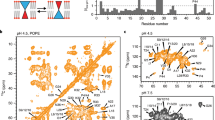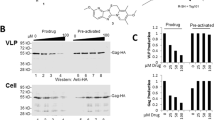Abstract
The M2 protein from influenza A virus is a pH-activated proton channel that mediates acidification of the interior of viral particles entrapped in endosomes. M2 is the target of the anti-influenza drugs amantadine and rimantadine; recently, resistance to these drugs in humans, birds and pigs has reached more than 90% (ref. 1). Here we describe the crystal structure of the transmembrane-spanning region of the homotetrameric protein in the presence and absence of the channel-blocking drug amantadine. pH-dependent structural changes occur near a set of conserved His and Trp residues that are involved in proton gating2. The drug-binding site is lined by residues that are mutated in amantadine-resistant viruses3,4. Binding of amantadine physically occludes the pore, and might also perturb the pKa of the critical His residue. The structure provides a starting point for solving the problem of resistance to M2-channel blockers.
This is a preview of subscription content, access via your institution
Access options
Subscribe to this journal
Receive 51 print issues and online access
$199.00 per year
only $3.90 per issue
Buy this article
- Purchase on Springer Link
- Instant access to full article PDF
Prices may be subject to local taxes which are calculated during checkout




Similar content being viewed by others
References
Deyde, V. M. et al. Surveillance of resistance to adamantanes among influenza A(H3N2) and A(H1N1) viruses isolated worldwide. J. Infect. Dis. 196, 249–257 (2007)
Tang, Y., Zaitseva, F., Lamb, R. A. & Pinto, L. H. The gate of the influenza virus M2 proton channel is formed by a single tryptophan residue. J. Biol. Chem. 277, 39880–39886 (2002)
Grambas, S., Bennett, M. S. & Hay, A. J. Influence of amantadine resistance mutations on the pH regulatory function of the M2 protein of influenza A viruses. Virology 191, 541–549 (1992)
Bright, R. A., Shay, D. K., Shu, B., Cox, N. J. & Klimov, A. I. Adamantane resistance among influenza A viruses isolated early during the 2005–2006 influenza season in the United States. J. Am. Med. Assoc. 295, 891–894 (2006)
Pinto, L. H. et al. A functionally defined model for the M2 proton channel of influenza A virus suggests a mechanism for its ion selectivity. Proc. Natl Acad. Sci. USA 94, 11301–11306 (1997)
Sansom, M. S. P., Kerr, I. D., Smith, G. R. & Son, H. S. The influenza A virus M2 channel: a molecular modeling and simulation study. Virology 233, 163–173 (1997)
Zhong, Q. F., Newns, D. M., Pattnaik, P., Lear, J. D. & Klein, M. L. Two possible conducting states of the influenza A virus M2 ion channel. FEBS Lett. 473, 195–198 (2000)
Ayton, G. S. & Voth, G. A. Multiscale simulation of transmembrane proteins. J. Struct. Biol. 157, 570–578 (2007)
Hu, F., Fu, R. & Cross, T. A. The chemical and dynamic influence of the drug amantadine on the M2 proton channel transmembrane domain. Biophys. J. 93, 276–283 (2007)
Hu, J. et al. Histidines, heart of the hydrogen ion channel from influenza A virus: toward an understanding of conductance and proton selectivity. Proc. Natl Acad. Sci. USA 103, 6865–6870 (2006)
Takeuchi, H., Okada, A. & Miura, T. Roles of the histidine and tryptophan side chains in the M2 proton channel from influenza A virus. FEBS Lett. 552, 35–38 (2003)
Duff, K. C. & Ashley, R. H. The transmembrane domain of influenza A M2 protein forms amantadine-sensitive proton channels in planar lipid bilayers. Virology 190, 485–489 (1992)
Salom, D., Hill, B. R., Lear, J. D. & DeGrado, W. F. pH-dependent tetramerization and amantadine binding of the transmembrane helix of M2 from the influenza A virus. Biochemistry 39, 14160–14170 (2000)
Cady, S. D., Goodman, C., Tatko, C. D., DeGrado, W. F. & Hong, M. Determining the orientation of uniaxially rotating membrane proteins using unoriented samples: a 2H, 13C, AND 15N solid-state NMR investigation of the dynamics and orientation of a transmembrane helical bundle. J. Am. Chem. Soc. 129, 5719–5729 (2007)
Stouffer, A. L., Nanda, V., Lear, J. D. & DeGrado, W. F. Sequence determinants of a transmembrane proton channel: an inverse relationship between stability and function. J. Mol. Biol. 347, 169–179 (2005)
Wang, J., Kim, S., Kovacs, F. & Cross, T. A. Structure of the transmembrane region of the M2 protein H+ channel. Protein Sci. 10, 2241–2250 (2001)
MacKinnon, R. Potassium channels. FEBS Lett. 555, 62–65 (2003)
Wang, C., Takeuchi, K., Pinto, L. H. & Lamb, R. A. Ion channel activity of influenza A virus M2 protein: characterization of the amantadine block. J. Virol. 67, 5585–5594 (1993)
Czabotar, P. E., Martin, S. R. & Hay, A. J. Studies of structural changes in the M2 proton channel of influenza A virus by tryptophan fluorescence. Virus Res. 99, 57–61 (2004)
Bright, R. A. et al. Incidence of adamantane resistance among influenza A (H3N2) viruses isolated worldwide from 1994 to 2005: a cause for concern. Lancet 366, 1175–1181 (2005)
De Clercq, E. Antiviral agents active against influenza A viruses. Nature Rev. Drug Discov. 5, 1015–1025 (2006)
Senes, A., Engel, D. E. & DeGrado, W. F. Folding of helical membrane proteins: the role of polar, GxxxG-like and proline motifs. Curr. Opin. Struct. Biol. 14, 465–479 (2004)
Nishimura, K., Kim, S. G., Zhang, L. & Cross, T. A. The closed state of a H+ channel helical bundle combining precise orientational and distance restraints from solid state NMR-1. Biochemistry 41, 13170–13177 (2002)
Bauer, C. M., Pinto, L. H., Cross, T. A. & Lamb, R. A. The influenza virus M2 ion channel protein: probing the structure of the transmembrane domain in intact cells by using engineered disulfide cross-linking. Virology 254, 196–209 (1999)
Hu, J. et al. Backbone structure of the amantadine-blocked trans-membrane domain M2 proton channel from influenza A virus. Biophys. J. 92, 4335–4343 (2007)
Jiang, Y. et al. Crystal structure and mechanism of a calcium-gated potassium channel. Nature 417, 515–522 (2002)
Betakova, T., Ciampor, F. & Hay, A. J. Influence of residue 44 on the activity of the M2 proton channel of influenza A virus. J. Gen. Virol. 86, 181–184 (2005)
Mould, J. A. et al. Mechanism for proton conduction of the M2 ion channel of influenza A Virus. J. Biol. Chem. 275, 8592–8599 (2000)
Gandhi, C. S. et al. Cu(II) inhibition of the proton translocation machinery of the influenza A virus M2 protein. J. Biol. Chem. 274, 5474–5482 (1999)
Holsinger, L. J., Nichani, D., Pinto, L. H. & Lamb, R. A. Influenza A virus M2 ion channel protein: a structure-function analysis. J. Virol. 68, 1551–1563 (1994)
Schnell, J. R. & Chou, J. J. Structure and mechanism of the M2 proton channel of influenza A virus. Nature doi: 10.1038/nature06531 (this issue)
Choma, C., Gratowski, H., Lear, J. D. & DeGrado, W. F. Asparagine-mediated self-association of a model transmembrane helix. Nature Struct. Biol. 7, 161–166 (2000)
Otwinowski, Z. & Minor, W. Processing of X-ray diffraction data collected in oscillation mode. Methods Enzymol. 276, 307–326 (1997)
Matthews, B. W. Solvent content of protein crystals. J. Mol. Biol. 33, 491–497 (1968)
Read, R. J. Pushing the boundaries of molecular replacement with maximum likelihood. Acta Crystallogr. D57, 1373–1382 (2001)
Collaborative Computational Project Number 4. The CCP4 suite: programs for protein crystallography. Acta Crystallogr. D50, 760–763 (1994)
Murshudov, G. N., Vagin, A. A. & Dodson, E. J. Refinement of macromolecular structures by the maximum-likelihood method. Acta Crystallogr. D53, 240–255 (1997)
Brünger, A. T. et al. Crystallography & NMR system: a new software suite for macromolecular structure determination. Acta Crystallogr. D54, 905–921 (1998)
Emsley, P. & Cowtan, K. Coot: model-building tools for molecular graphics. Acta Crystallogr. D60, 2126–2132 (2004)
SMART, SAINT, SADABS, and XPREP Software Reference Manual (Bruker, AXS Inc., Madison, Wisconsin, 2000)
Schweiters, C. D., Kuszewski, J. J., Tjandra, N. & Clore, G. M. The Xplor-NIH NMR molecular structure determination package. J. Magn. Reson. 160, 66–74 (2003)
Christopher, A. J., Swanson, R. & Baldwin, T. O. Algorithms for finding the axis of a helix: fast rotational and parametric least-squares methods. Comput. Chem. 20, 339–345 (1996)
Acknowledgements
This work was primarily supported by a grant from the National Institute of General Medical Studies of the National Institutes of Health. We also acknowledge support from the Kimberly DeLape and Margaret DeLape Fellowship, the University of Pennsylvania’s MRSEC program, and the Nano/Bio Interface Center funded through the National Science Foundation. D.S. was a recipient of a postdoctoral fellowship from the Ministerio de Educación y Cultura (Spain). We thank J. Lear, L. Pinto, R. Lamb, L. Cristian, A. Polischuk, T. Kossiakoff, D. Christianson, M. Lewis and J. Chou for stimulating discussions. We also thank E. Jeavons, L.-H. (P.) Huang and K. Ellis for technical assistance.
Author Contributions D.S. grew the first high-resolution crystals of variants of M2TM, including the drug-free form reported here. A.L.S. selected additional variants and crystallized many other forms including the amantadine complex reported here. R.A. solved and refined both structures, and L.D.C. solved a monomeric form of M2TM used in molecular replacement. Data for the drug-free and amantadine-containing crystals were collected by S.S. and A.L.S., respectively. A.S.L. and V.T. also contributed to crystallization and data collection for crystal forms that were critical to obtaining and interpreting the crystal forms reported here. A.L.S., R.A., L.D.C., V.T. and S.S. processed and interpreted diffraction data. W.F.D., A.L.S., A.S.L., R.A., C.S.S. and V.N. each contributed to the analysis and understanding of the implications of the structure. C.S.S. and V.N. performed molecular modelling. W.F.D., A.S.L., A.L.S., R.A. and C.S.S. wrote the manuscript in consultation with the remaining authors. W.F.D. grew the first low-resolution crystals and supervised the project.
Author information
Authors and Affiliations
Corresponding author
Ethics declarations
Competing interests
W.F.D. chairs the scientific advisory board of InfluMedix, a company that is working on the pharmaceutical intervention of influenza virus infections.
Supplementary information
Supplementary Information
The file contains Supplementary Figures 1–2 with Legends, which show the electron density of the interhelical salt bridge, the ordered detergent of the crystal lattice, heavy atom locations, and a structure based model of the S31N mutation. The file also includes crystallographic statistics (Supplementary Table 1). (PDF 234 kb)
Rights and permissions
About this article
Cite this article
Stouffer, A., Acharya, R., Salom, D. et al. Structural basis for the function and inhibition of an influenza virus proton channel. Nature 451, 596–599 (2008). https://doi.org/10.1038/nature06528
Received:
Accepted:
Issue Date:
DOI: https://doi.org/10.1038/nature06528
This article is cited by
-
Amantadine inhibits known and novel ion channels encoded by SARS-CoV-2 in vitro
Communications Biology (2021)
-
Atomic structures of closed and open influenza B M2 proton channel reveal the conduction mechanism
Nature Structural & Molecular Biology (2020)
-
Single-chain heteropolymers transport protons selectively and rapidly
Nature (2020)
-
Adamantane Derivatives Containing Thiazole Moiety: Synthesis, Antiviral and Antibacterial Activity
International Journal of Peptide Research and Therapeutics (2020)
-
pH-dependent secondary structure propensity of the influenza A virus M2 cytoplasmic tail
Biomolecular NMR Assignments (2020)
Comments
By submitting a comment you agree to abide by our Terms and Community Guidelines. If you find something abusive or that does not comply with our terms or guidelines please flag it as inappropriate.



